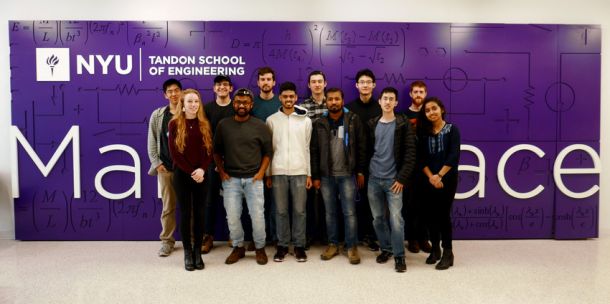Mining Mars: Robotics Design Team builds robot for NASA competition

Captain of the NYU Robotics Design Team, Orion Doscher (center), working with teammates on their entry in NASA’s Annual Robotic Mining Competition
Since discovering the existence of water on Mars, NASA’s Annual Robotic Mining Competition challenges university teams to envision and build a mining robot to navigate and excavate Mars’ terrain in order to reveal water ice beneath the Martian soil. As NASA looks ahead towards the future of populating Mars, finding and mining water from ice and minerals on Mars is essential towards making that goal a reality.
At the competition, robots must remotely navigate NASA’s simulated Martian landscape and collect over 10kg of simulated Martian soil, called regolith, all within a ten-minute time frame. Robots are judged on weight, power consumption, bandwidth usage, and autonomy, as well the team’s technical paper, all of which garner points towards attaining the Joe Kosmo Award for Excellence.
Participating in its sixth Robotic Mining competition, the NYU Robotics Design Team will compete for the first time as NYU Tandon, and team captain Orion Doscher ’18 hopes they will take home the top prize. Though this year’s Robotic Mining challenge will be their last, the team plans to take on different NASA competitions in the coming years.
Comprised of 29 students ranging from first-year undergraduates to Master’s and Ph.D. students, the Tandon team has been tirelessly working on their design, starting the first build of the robot over winter break. Featuring four-wheel drive, the design boasts an innovative wheel-mining system, in which the wheels both drive the robot forwards and backwards and also dig and deposit dirt into a collecting bin. The Tandon team was one of the first teams to debut this digging wheel design at the competition.

The NYU Robotics Design Team
With its use of carbon fiber and 3D-printed material, made with the Makerspace’s 3D-printing facilities, their robot will be one of the most lightweight in the competition. “We’re going for the lightest, most compact design we can make to actually complete the task,” Doscher said. “The reason we used 3D printing is because it’s modular, we can adjust for size, and we can fix parts. If they break, we have replacements very quickly.” Full autonomy is another goal for the team’s robot, which will use a camera navigation system to perform real-time, onsite learning that maps the simulated terrain without the need for human interference. As more points are awarded to the team with the most efficient communications systems, NYU Robotics Design is developing a system using the ‘heartbeat’ concept, which sends repeated signals or beats between the robot and a remote computer system to keep the connection alive. “This system can guarantee stabilized and low-delay connection between a ground control station and the robot, with ultra-low bandwidth usage,” Chaoyue Wang ’18, the team’s Network Lead, said.
NASA judges also factor in the team’s social media presence and their outreach work within their communities. NYU Robotics Design partnered with Brooklyn Tech High School’s FIRST Robotics team and the non-profit Code Interactive to mentor students on coding, designing and building robots, and learning new software. “The work that we do with children in STEM is really important,” Doscher said. “A lot of our teammates are Brooklyn Tech alumni and FIRST Robotics team alumni. Our team will have a lot of valuable advice for the students.” Doscher and her teammates will also be advising students from University Heights High School in the Bronx as the students design and program their robot for the FIRST Tech Challenge, encouraging the young students to pursue their love of robot design, as it could someday land them at NASA.
On May 22-26, the Tandon team will travel to the Kennedy Space Center in Florida and compete alongside 37 teams from across the U.S. Though winning the top award is one of the main goals, Doscher is looking forward to the “incredible environment” and camaraderie between the teams that she witnessed at last year’s competition. As she and her teammates prepare for the robot’s debut in May, perfecting the mechanical and network aspects of the mining rover are top priority, as well as having fun along the way.
Camila Ryder
Graduate School of Arts and Science
Master of Arts in English Literature, Class of 2018




